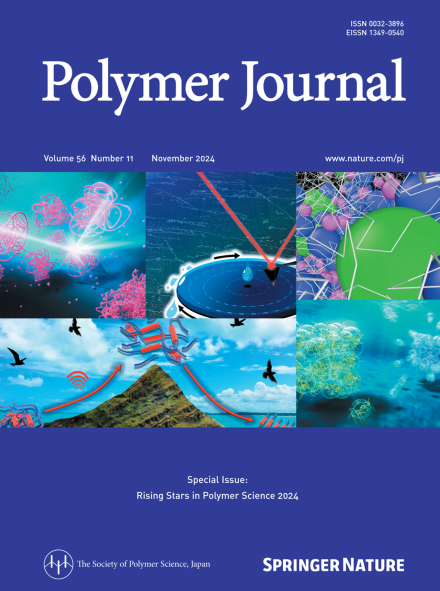在相分离的二元溶剂体系中通过一次自由基聚合轻松合成宏观双层凝胶
IF 2.3
4区 化学
Q3 POLYMER SCIENCE
引用次数: 0
摘要
一种宏观双层凝胶材料因其独特的各向异性而具有很大的研究潜力;然而,由于凝胶层需要牢固的粘附性,使用简易合成方法制备双层凝胶的研究受到限制。在本研究中,我们开发了一种简单而通用的在相分离的二元溶剂体系中用自由基聚合法制备双层凝胶的一次性合成方法。在两亲交联剂的存在下,丙烯酸丁酯和丙烯酰胺在甲苯/水相分离的溶液中光聚合产生高度可复制的双层凝胶。所得的双层凝胶表现出选择性膨胀行为和独特的力学性能,这源于每层聚合物的性质。此外,混合溶剂层的体积或界面处形成的乳化层的体积对双层凝胶的力学性能有显著影响。重要的是,该合成方法对各种溶剂和单体具有广泛的适用性。例如,我们使用合适的反应溶剂成功合成了含有热敏聚合物层的双层水凝胶;用简单的溶剂取代法将这些反应溶剂取代水。所制备的双层水凝胶具有独特的功能,如热响应性各向异性变形和抽水行为。采用相分离二元溶剂体系,通过光诱导自由基聚合制备双分子层凝胶,建立了一种简便、通用的一次性合成方法。使用可溶于两相的两亲性交联剂对于形成充分粘合的界面尤为重要。由于其在各种溶剂和单体中的广泛适用性,这种合成方法提供了多种双层结构。所得的双层凝胶具有独特的功能,如选择性膨胀行为、机械性能和各向异性变形。本文章由计算机程序翻译,如有差异,请以英文原文为准。

Facile synthesis of macroscopic bilayer gels by one-shot radical polymerization in phase-separated binary solvent systems
A macroscopic bilayer gel material has potential for great research interest because of its unique anisotropic behavior; however, studies using a facile synthetic method for preparing a bilayer gel are limited since the gel layers need firm adhesion. In this study, we developed a simple and versatile one-shot synthetic method for preparing bilayer gels using radical polymerization in a phase-separated binary solvent system. Photopolymerization of t-butyl acrylate and acrylamide in a toluene/water phase-separated solution in the presence of an amphiphilic crosslinker produced a highly reproducible bilayer gel. The obtained bilayer gels exhibited selective swelling behavior and unique mechanical properties derived from the properties of each polymer layer. In addition, the mechanical properties of the bilayer gels were significantly affected by the volume of the mixed solvent layer or the emulsified layer formed at the interface. Importantly, this synthetic method has broad applicability to various solvents and monomers. For example, we successfully synthesized a bilayer hydrogel containing a thermoresponsive polymer layer using appropriate reaction solvents; these reaction solvents were substituted for water using a simple solvent substitution process. The resulting bilayer hydrogel exhibited unique functions, such as thermoresponsive anisotropic deformation and water pumping behavior. A facile and versatile one-shot synthetic method for preparing bilayer gels was developed through photoinduced radical polymerization using a phase-separated binary solvent system. The use of an amphiphilic crosslinker soluble in both phases was particularly important for forming a sufficiently adhesive interface. This synthetic method provides a wide variety of bilayer structures due to its broad applicability in various solvents and monomers. The resulting bilayer gels exhibited unique functions, such as selective swelling behavior, mechanical properties, and anisotropic deformation derived from the properties of each polymer layer.
求助全文
通过发布文献求助,成功后即可免费获取论文全文。
去求助
来源期刊

Polymer Journal
化学-高分子科学
CiteScore
5.60
自引率
7.10%
发文量
131
审稿时长
2.5 months
期刊介绍:
Polymer Journal promotes research from all aspects of polymer science from anywhere in the world and aims to provide an integrated platform for scientific communication that assists the advancement of polymer science and related fields. The journal publishes Original Articles, Notes, Short Communications and Reviews.
Subject areas and topics of particular interest within the journal''s scope include, but are not limited to, those listed below:
Polymer synthesis and reactions
Polymer structures
Physical properties of polymers
Polymer surface and interfaces
Functional polymers
Supramolecular polymers
Self-assembled materials
Biopolymers and bio-related polymer materials
Polymer engineering.
 求助内容:
求助内容: 应助结果提醒方式:
应助结果提醒方式:


